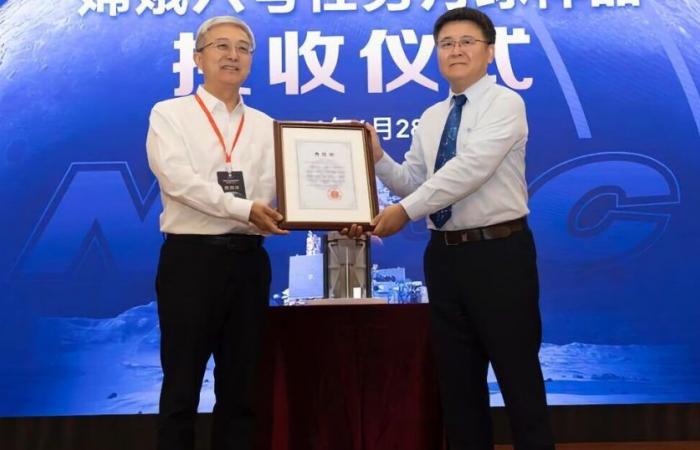The delivery ceremony for lunar samples collected by the Chang’e-6 mission of the China Space Agency was held today in Beijing. During the event, CNSA General Administrator Zhang Kejian handed over the capsule containing the samples to Ding Chibiao, vice president of the Chinese Academy of Sciences. The container will now be transported to the dedicated laboratory, where the samples will be catalogued and made available to the scientific community at home and abroad.
During the ceremony, the quantity of material samples coming from the surface of the Apollo crater, on the far side of the Moon, was also certified: 1935.3 grams. The objective of the mission was to collect 2 kg, so we can speak of complete success for Chang’e-6. This is a greater quantity than that brought home by the twin mission Chang’e-5.which performed the same operation on the more accessible side of the Moon, collecting 1731 grams. Among the scientific results obtained by Chang’e-5 are the discovery of a new mineral and the collection of the youngest basalt layer ever collected on the Moon. Expectations for the samples of Chang’e-6 are even higher, given the large difference in composition that characterizes the far side of the Moon.
China’s Chang’e-6 mission makes history: samples from the far side of the Moon returned to Earth
Go to further information
For the Chinese Space Agency, this is yet another extraordinary result achieved, due to the great technological complexity inherent in managing to land a probe on the far side of the Moon, not to mention the return of the samples to Earth. To make up for the lack of visibility from Earth, the CNSA sent a special repeater satellite for the mission, Queqiao-2, into lunar orbit. All the complex activities of the mission were carried out autonomously by the different components of the Chang’e-6 probe.
The analysis of the surface of the Apollo crater is preparatory to the next objectives of the Chinese space program: reporting on Man on the Moon and building a permanent outpost on its surface. According to the timetable presented last year, lChina intends to put a crew on the Moon as early as 2030.






